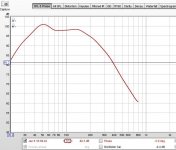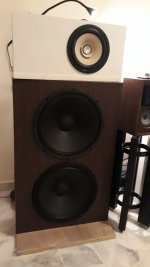Hi, this topic was discussed before and many has stated there is no advantage in using a push pull (or Isobaric) configuration. For OB this is no advantage, I can understand that.
I have built the OB bass in a H frame using 15" and the bass is fast and quick. The cross over is done electronically, using 4X active filters feeding 4x200W amplifiers. Each driver has a dedicated amp. By listening tests, the bass is not deep enough. I may use the DSP to do a low end shelf , but I tried before using 12" drivers in previous builds, the bass was still very weak. I suppose the limitation is mainly from the driver itself.
I have spare 15" drivers. If I configure the drivers in a push pull fashion, with the aim to lower the bass response will it be possible. (one side having 4X 15", 2 facing front, and 2 at the back pushing the front drivers. A small air chamber per pair of drivers in the same axis. The rear driver back is open to the rear). Will the bass extend to below 20-30Hz? If not, what is the a better way to make the bass deeper. (I have a decent listening space.)
Thank you.
I have built the OB bass in a H frame using 15" and the bass is fast and quick. The cross over is done electronically, using 4X active filters feeding 4x200W amplifiers. Each driver has a dedicated amp. By listening tests, the bass is not deep enough. I may use the DSP to do a low end shelf , but I tried before using 12" drivers in previous builds, the bass was still very weak. I suppose the limitation is mainly from the driver itself.
I have spare 15" drivers. If I configure the drivers in a push pull fashion, with the aim to lower the bass response will it be possible. (one side having 4X 15", 2 facing front, and 2 at the back pushing the front drivers. A small air chamber per pair of drivers in the same axis. The rear driver back is open to the rear). Will the bass extend to below 20-30Hz? If not, what is the a better way to make the bass deeper. (I have a decent listening space.)
Thank you.
Attachments
Measure the frequency response at the listening position and equalize that response. At low frequencies, this is what you are listening to after all.By listening tests, the bass is not deep enough. I may use the DSP to do a low end shelf , but I tried before using 12" drivers in previous builds, the bass was still very weak. I suppose the limitation is mainly from the driver itself.
What do you mean by 'weak'? Softer than the midrange? Insufficient SPL capability?
If I understand correctly, what you are proposing is isobaric, just with a small air volume between the woofers. It will not do anything in an open baffle. The resonance frequency and Q will remain the same. Air displacement and therefore SPL capability also will not change.If I configure the drivers in a push pull fashion, with the aim to lower the bass response will it be possible. (one side having 4X 15", 2 facing front, and 2 at the back pushing the front drivers. A small air chamber per pair of drivers in the same axis. The rear driver back is open to the rear). Will the bass extend to below 20-30Hz?
Equalization is the way to go. 20 Hz might not be loud enough with an open baffle woofer. The SPL capability can be increased by adding wings to the baffle.If not, what is the a better way to make the bass deeper. (I have a decent listening space.)
Last edited:
It is worth noting that push-pull has nothing to do with isobarik (except that an isobarik can be configured push-pull.
dave
Yes indeed. Thank you Dave.
Hi TBTL,
Thanks for the helps. I am too used to listening to KEF speakers for many many years. (104, 105.2, 105.4 etc) Maybe I am used to the bouncy bass of British speakers. The bass on the OB does not apparently go deep. The measurements of the KEFs is about the same (fast roll at 80hz) , but they sound more deep. It is more of perception and feel.
Thanks for the confirmation that isobaric is not going to help.
I have added small wing (about 6 inches on both sides of the baffle). How much more should I add? I have read about the effects of wings on bass extension.
Thank you!
Thanks for the helps. I am too used to listening to KEF speakers for many many years. (104, 105.2, 105.4 etc) Maybe I am used to the bouncy bass of British speakers. The bass on the OB does not apparently go deep. The measurements of the KEFs is about the same (fast roll at 80hz) , but they sound more deep. It is more of perception and feel.
Thanks for the confirmation that isobaric is not going to help.
I have added small wing (about 6 inches on both sides of the baffle). How much more should I add? I have read about the effects of wings on bass extension.
Thank you!
Measure the frequency response at the listening position and equalize that response. At low frequencies, this is what you are listening to after all.
What do you mean by 'weak'? Softer than the midrange? Insufficient SPL capability?
If I understand correctly, what you are proposing is isobaric, just with a small air volume between the woofers. It will not do anything in an open baffle. The resonance frequency and Q will remain the same. Air displacement and therefore SPL capability also will not change.
Equalization is the way to go. 20 Hz might not be loud enough with an open baffle woofer. The SPL capability can be increased by adding wings to the baffle.
Hi TBTL,
I am too used to listening to KEF speakers for many many years. (104, 105.2, 105.4 etc) Maybe I am used to the bouncy bass of British speakers.
There are plenty of people who don't like OB bass presentation. I personally prefer a well-built and braced box for that visceral physicality.
IMHO, OB bass is "different" than boxed bass. It could be that you just dont like it and its absence of "visceral physicality" is the missing characteristic. (Nice term, BTW)
It doesnt propagate, like certain automobiles that drive past and can saturate the whole house with their bass notes as they do. This can be advantageous in certain situations, but if you find it unsatisfying personally - and have no reason to not shake the Earth and everything else in your vicinity - you may have to go back to a box to get it.
It doesnt propagate, like certain automobiles that drive past and can saturate the whole house with their bass notes as they do. This can be advantageous in certain situations, but if you find it unsatisfying personally - and have no reason to not shake the Earth and everything else in your vicinity - you may have to go back to a box to get it.
Thanks for the subjective description.I am too used to listening to KEF speakers for many many years. (104, 105.2, 105.4 etc) Maybe I am used to the bouncy bass of British speakers. The bass on the OB does not apparently go deep. The measurements of the KEFs is about the same (fast roll at 80hz), but they sound more deep. It is more of perception and feel.
To translate it to engineering stuff, it would help to have measurements of the frequency response at the listening position. My hypothesis is that these will differ between the KEF and OB and that this causes the difference in perceived sound. This can be validated by equalizing the OB such that its frequency response, as measured at the listening position, matches the frequency response of the KEF speaker (again, measured at the listening position) and comparing the perceived sound. If both systems turn out to sound similar, it can be concluded that equalization of the OB will be sufficient to make the OB sound similar to the KEF and therefore to your liking.
Wings do not extend the bass response, they just make everything louder (up to some frequency determined by the size of the dipole, which will be somewhere around 400 Hz). Louder is good because it allows for heavier equalization and reduces strain on the woofer, which reduces harmonic distortion. How large you can make the wings depends on aesthetics and the upper frequency of the frequency domain the woofer is reproducing. If the wings are too large of the H frame too deep, either polar pattern will suffer at the upper end of the woofers frequency range or, in the case of H frames, the 1/4 wavelength resonance will decrease too much and enter the woofers frequency range.I have added small wing (about 6 inches on both sides of the baffle). How much more should I add? I have read about the effects of wings on bass extension.
Last edited:
IMHO, OB bass is "different" than boxed bass. It could be that you just dont like it and its absence of "visceral physicality" is the missing characteristic. (Nice term, BTW)
I've got OB bass and IB (in the wall) From what I've read and my experience the difference is due to momentary room pressurisation that OB doesn't have. I find this pressurisation quite uncomfortable on my ears, it might be an age thing.
Ears respond to sound pressure only, so (sound) pressurisation is good. Without, there is no audible sound. This assumes that you have an equalizer to equalize the frequency response to your liking, so excess bass and booming at certain room modes can be reduced.
At frequencies below the lowest room mode, monopoles can pressurize the room while dipoles cannot. This just means that monopoles are louder at these frequencies.
At frequencies below the lowest room mode, monopoles can pressurize the room while dipoles cannot. This just means that monopoles are louder at these frequencies.
Last edited:
You can get a nice visceral physicality from Open Baffles, but it is not cheap.
4 B&C 18IPAL or 18DS115 (low Qts, high Bl drivers) per channel in a PPSL arrangement with plenty of EQ and good amps will add some perceived "muscle" and "visceral physicality". It takes a large radiating area, high Bl, low Qts and some compression of the air in front of the drivers (hence PPSL).
4 B&C 18IPAL or 18DS115 (low Qts, high Bl drivers) per channel in a PPSL arrangement with plenty of EQ and good amps will add some perceived "muscle" and "visceral physicality". It takes a large radiating area, high Bl, low Qts and some compression of the air in front of the drivers (hence PPSL).
You say you have spare drivers and looking for deeper bass: 20-30 Hz. These frequencies are very omnidirectional. You make a separate TL just for this region - low-pass on where the OB starts - and place on a different spot.
I know vented is not your taste, but would it really make a difference if you just use it for this little extension?
I know vented is not your taste, but would it really make a difference if you just use it for this little extension?
- Status
- This old topic is closed. If you want to reopen this topic, contact a moderator using the "Report Post" button.
- Home
- Loudspeakers
- Subwoofers
- Push Pull bass for OB


